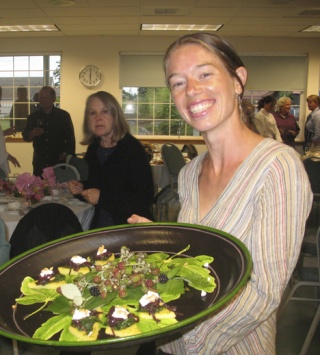Soltman looks forward to the day when local farmers consider the district’s needs when they decide what to plant — and market their foods to the district.
If chef Tom French of Whidbey Island has his way, San Juan Island School District students will be eating fresh, locally grown — and sometimes organic — hot lunches at school.
Because of a deficit, the district’s food service budget has not been restored. But instead of simply replacing last year’s program, French wants to go one better.
French is director of the Experience Food Project. He is working closely with district officials, private donors and government representatives to establish a never-been-done-before pilot program on San Juan: combining federal funds and local grants to put locally produced foods on the lunch line.
“Clearly, the way we’re going about it right now isn’t working,” French said of traditional food services.
As the creative force behind the endeavor, French is something of a crusader for changing current eating habits into much more healthy ones. Learning about the issues surrounding food is a big part of his program.
“We think people have moved too far away from food as a human experience,” French said. “It’s important that kids, through their experience with food, regain a sense of place and belonging.”
French’s program combines grant money from Connie and Steve Ballmer working through the San Juan Community Foundation, the school district and the U.S. Department of Agriculture’s school lunch program to make it happen.
Central to, and perhaps familiar to some, are the recurring menu items that cycle-through the school year usually every six weeks. These “cycle menus” are the axle around which school-lunch economics revolves: cost predictability.
“We undertook an extensive survey on seasonal availability of local foods and came up with a whole new set of cycle menus that we think are more contemporary, both scientifically and philosophically, and more in tune with what we know about nutrition in 2008,” French said.
According to San Juan Superintendent Michael Soltman, gone will be the high fat, overly processed foods familiar to school kids everywhere: chicken nuggets and greasy pizza.
“We’ll still have hamburgers, but we’ll have local grass-fed meat,” Soltman said. At the middle school and high school, there will be three healthy choices: a main entree, a soup and salad bar, and a grab-and-go sandwich area.
The choices offered for the elementary school are still being worked on, as no cooking is done on site, but rather it’s brought over after being prepared at the high school.
French’s intentions don’t stop at the cafeteria door. His proposal takes the complex issues of food and our current system of procuring it, processing it and consuming it, and examines those systems in core classes.
“There are thousands of opportunities for integrated learning that at compatible with basic skills such as math, science and reading…” French wrote in a draft status report earlier this year to the school board.
French has been working with different officials from different agencies to try and overcome institutional resistance to outside-the-box thinking.
“A core assumption of this project is that the current infrastructure will likely be unable to accommodate contemporary thought processes around food and food systems, [nor] provide the flexibility needed to explore and implement locally-based solutions,” French wrote.
Last year, the district served an average of 310 meals per day and received $65,000 from the federal government for students who qualify for the federal free and reduced lunch program.
The federal government only subsidizes families who qualify for the program as other students pay full fare, Soltman said. The food program also gets $2,500 from the state of Washington, and out-of-pocket lunch fees generate $105,000. The federal subsidy for free and reduced lunches is $2.57 and $2.17 respectively.
Even with the subsidy, food service revenue was not enough to cover the cost of the program and the district had to pay the difference, between $30,000 and $50,000 annually, Soltman said.
“That money comes out of the general fund. What that means is that we’re not able to hire the staff we need in other places.”
Soltman would like to see a higher participation rate in the new program, not just with students, but across the whole community, he said. “We’ve had about a 30 percent participation rate. We’d like to see a 50 percent rate, minimum. I’d like to see it higher than that.”
That should be easier as the federal government has made it easier to qualify for the free and reduced lunch program this year. Soltman and French are pushing to get the word out about how important it is to return the necessary paperwork that comes home with students in the first days of school.
“I’ve been working with the Family Resource Center to find out how we can get people to fill out the paperwork. The need to know that they’re actually doing us a favor by doing so,” French said. “And guess what — it’s our money.”
Soltman said that the program will be evaluated to see if it’s sustainable and looks forward to the day when local farmers take the district’s needs into consideration when they decide what to plant, and market their foods to the district.
“That’s the goal,” Soltman said. “When we can make agreements with local farmers for specific quantities of things. A huge part of this is getting people back involved in the school lunch program — parents and the community.”
French and district officials will host an open house Thursday, 4:30 p.m. in the Friday Harbor High School commons.



